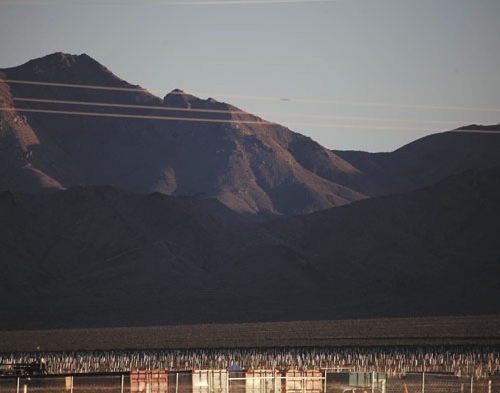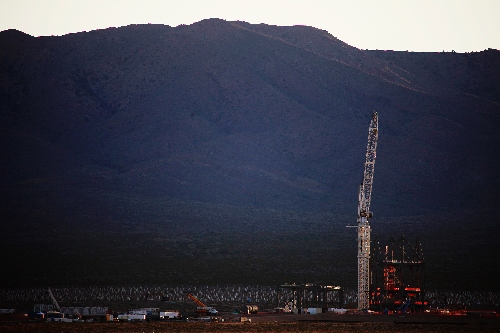Nevada imagines exporting excess renewable power, but California has the same plan
Renewable energy will save Nevada.
At least, that's the idea. Build solar, geothermal and wind plants, and not only will the Silver State meet its legal quota for clean energy, but it'll have leftovers to export to huge markets such as California -- thereby diversifying the economy. It's a classic case of doing well by doing good.
There's just one problem.
California's thinking the same thing.
In a recent letter to federal officials, and at last week's National Clean Energy Summit, California officials said they can meet green-energy needs with thousands of spare megawatts for export.
"How much we import has to be balanced with how much we're building locally," said California Gov. Jerry Brown at the summit. "With solar-photovoltaic prices coming down, there's a real rush to put up panels on shopping center roofs, school roofs and along freeways. We're going to generate a lot of energy, and hopefully, we're going to be able to export. I think integration (with other states) is good, but we're going to try to build as much indigenously as we can."
By all accounts, California could build a lot. That may mean trouble for planned transmission lines across Nevada, said Eric Witkoski, the state consumer advocate who represents ratepayers in electricity rate cases.
"Some people painted it as a big gold rush in California. But they already have their own gold," Witkoski said.
GOLDEN STATE POTENTIAL
An Aug. 3 letter from Brown's clean-power adviser, Michael Picker, shows just how much potential renewable energy California has.
Picker wrote Brad Nickell, a director of the Western Electricity Coordinating Council in Utah, to outline how California's renewables market has changed. Picker's letter highlighted big prospects.
California's renewable portfolio standard says the state's utilities must get 33 percent of their electricity from renewables by 2020. That means they'll need 20,000 megawatts from solar, geothermal or wind in the next decade.
In 2010 and 2011, California is on track to permit 10,000 megawatts of renewables. What's more, developers of more than 500 renewable projects totaling nearly 50,000 megawatts are seeking permits from the California Energy Commission. Picker also noted that the California Independent System Operator, a nonprofit transmission manager, says developers aim to link 70,000 megawatts of renewables to its grid. And energy trade publication Platts Electric Power Daily noted that Brown expects California to produce 12,000 megawatts of rooftop solar as well.
If the state could get 40 percent of its energy from renewables, then "we will be positioning ourselves for relationships with other load areas outside California and can hopefully provide mutual benefit in cost-efficient renewable market transfers," Picker wrote.
It's a goal that may dampen expectations for energy export from Nevada.
"I think initially, everybody thought the opportunity to export was going to be gigantic," said John Candelaria, a Henderson-based senior associate with Aspen Environmental Group, which provides environmental impact assessments and other services for energy developers and agencies, including the Nevada Bureau of Consumer Protection. "But I don't see how anyone can ignore (Gov. Brown's) official policy saying, 'We want it all to come from California, and we want to export.' "
That policy means Nevada developers must go slowly to avoid added economic stress for consumers, Witkoski said.
Local power utility NV Energy has built or bought 3,000 megawatts of generation in the last six years to avoid relying on pricey wholesale power during peak demand. To pay for those additions, general rates have nearly tripled since 2003, Witkoski said.
"If a developer is going to build transmission, we want them to proceed cautiously, so we don't cause more rate impacts not only on residents, but businesses," Witkoski said. "Going forward, economic models look a lot different. Growth will be a lot slower and more limited.''
One renewable transmission line is already being built in Nevada. The $510 million, 500-kilovolt One Nevada line (ON Line), which NV Energy and New York developer LS Power are building from Ely to Apex, will link NV Energy's northern and southern grids and carry renewables to its cities.
Witkoski said the 235-mile ON Line will create "synergies" within NV Energy but he questioned additional transmission the company might build, including as many as 500 miles of lines from Washoe County to Boulder City.
Until NV Energy can evaluate demand for the line, it can't say how much the lines would cost or how large they'd be. The deadline for developer solicitations of interest is Sept. 16.
In a Wednesday statement, NV Energy said it's exploring opportunities with California and other markets through its Renewable Transmission Initiative.
"This approach puts the onus on developers to make sure there is a demand for their renewable-energy projects," the company stated.
DEMAND FOR NEVADA RENEWABLES
There could be demand for some Nevada renewables outside the state.
Geothermal energy, abundant in Northern Nevada, costs less than other renewables. A 2010 Review-Journal comparison of renewables in Nevada found geothermal projects selling for 8.6 cents per kilowatt hour, compared to 13 cents per kilowatt hour from two solar projects. Geothermal also produces 24 hours a day. Cost and availability make geothermal attractive next to intermittent renewables such as solar and wind.
And then there's Valley Electric Association in Pahrump. The 23,000-member co-op just got the nod to join the California Independent System Operator, which could allow it to send solar power to the Golden State, Witkoski said.
Solar Express Transmission, a private firm, is two years into development of a line in the same area, and is working on financing the $200 million project.
Candelaria said tapping into the Independent System Operator is a smart strategy that could qualify Nevada-based projects as California resources for renewable-portfolio purposes. Other developers will have to be just as nimble to find success next door.
"Cost does matter. Transmission developers in this state have to make sure they understand the rules, and they have to be careful to follow the rules," Candelaria said. "They have to provide transmission solutions that make renewable projects as competitive as possible. If they can get energy connected to California in the cheapest way possible, it's my opinion that there are still opportunities for renewable developers in Nevada."
The question is how substantial those opportunities are anymore.
A big transmission developer stared that question in the face recently, and didn't like the answer.
In July Developer TransCanada sold its 1,000-mile, 500-kilovolt Zephyr transmission line still under construction from Medicine Bow, Wyo., to Las Vegas.
TransCanada said it didn't make sense to keep the $3 billion project given California's uncertain renewable market.
"Developers who are looking at these opportunities are just going to have to refine their approach," Witkoski said. "They're going to have to drill down and be specific on the numbers and whether they can be competitive. They may hold some attraction for some buyers in California. There may still be developers here who can offer a low-cost product. But it is going to be a challenge."
Contact reporter Jennifer Robison at
jrobison@reviewjournal.com or 702-380-4512.























